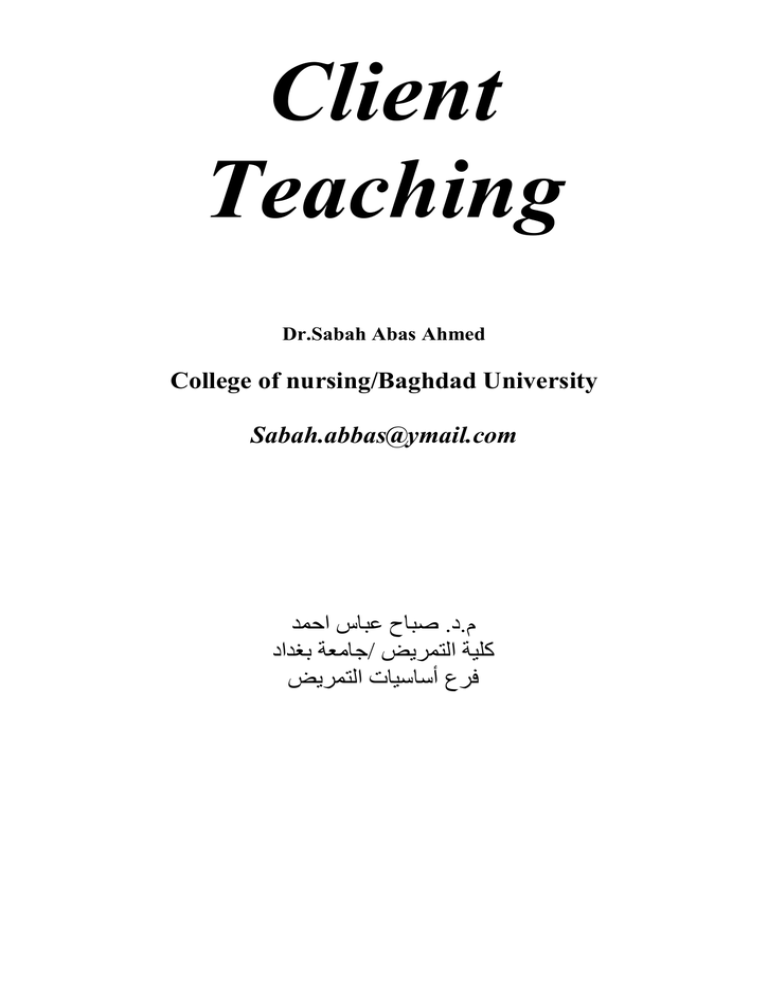Client Teaching College of nursing/Baghdad University
advertisement

Client Teaching Dr.Sabah Abas Ahmed College of nursing/Baghdad University Sabah.abbas@ymail.com صباح عباس احمد.د.م جامعة بغداد/ كلية التمريض فرع أساسيات التمريض Client Teaching Objectives : Define the term: -Learning, - Teaching -The formal , - Informal - Purposes of Client Teaching - Discuss the learning domain. - Describe principles of the learning _ Describe the teaching and learning process. _ Identify common barriers to learning. _ Describe the teaching _learning process to the nursing process. _ Describe methods for evaluating ,teaching and learning. Client teaching Client education is an integral part of nursing care. The nurse is responsible to help the client identify learning needs & resources that will restore & maintain that clients optimal level of functioning. Client education is extremely important today in a health care environment that demands cost-effective measures. With shorter hospital stays, clients are being discharged to the home or other health care settings in more critical condition than ever before. Client education, a hallmark of quality nursing care, is a fiscally responsible intervention that encourages health care consumers to engage in self-care and to develop healthy lifestyle practices. Teaching: is an active process in which one individual shares information with Others to provide them with the information to make behavioral changes. Teaching refers to all the activities used by a teacher to assist the learner to absorb new information; it consists of activities that promote change. Teaching is a goal-directed process that provides the opportunity for learning. Learning: is the process of assimilating information with a resultant change in behavior. or Learning is the individuals desire to learn & to act on the learnining , Nurses and clients have shared responsibilities in the teaching-learning process. By sharing know edge with clients, the nurse empowers clients to achieve their maximum level of wellness. Formal Teaching: Takes place at a specific time , in a specific place and on a specific topic, it is planned & goal directed. Informal Teaching: Takes place any time , any place whenever a Learning need is identified. While providing nursing care , nursing have many opportunities for informal teaching .Such as answering the clients questions& explaining care given to the client. The teaching- learning process The teaching-learning process is a planned interaction that promotes behavioral change that is not a result of maturation or coincidence. The teaching-learning process will be familiar to nurses in that it mirrors the steps of the nursing process: assessment, identification of learning needs (nursing diagnosis), planning, implementation of teaching strategies, and evaluation of learner progress and teaching efficacy. Purposes of Client Teaching According to Edelman and Mandle (1997), the goal of health education is to help individuals achieve optimum states of health through their own actions. Teaching, one of the most important nursing functions, addresses clients’ need for information. Often, a knowledge deficit about the course of illness and/or self-care practices inders a client’s recovering from illness or engaging in health promotion behaviors. The nurse’s charge is to help bridge the gap between what a client knows and what a client needs to know in order to achieve optimum health. Client teaching is done reasons, including: • Promotion of wellness for a variety of • Prevention of disease/injury • Restoration of health • Facilitation of coping abilities Each nurse needs to develop an individual philosophy (statement of beliefs that is the foundation for behavior) of learning. When formulating a philosophy about teaching- learning, nurses need to consider the common beliefs about learning listed in the accompanying display. Domains of Learning: Bloom, in his classic work (1977), identified three areas or domains in which learning occurs: the cognitive domain (intellectual understanding), the affective domain (emotions and attitudes), and the psychomotor domain (motor skills). Each domain responds to and processes information in very different ways. Cognitive domains : (intellectual understanding), Learning that involves Client states the acquisition of facts name and purpose and data. Used in problem solving and decision making . Clinical example Client states the of facts name and purpose of prescribed medications. Affective domains : (emotions and attitudes), Learning that involves changing attitudes, he has a emotions, beliefs. Used .in making judgments. Clinical example Client accepts that he has a chronic illness .Psychomotor domains : (motor skills) : Learning that involves gaining motor skills. Uses physical application of knowledge. Clinical example Client gives self an injection. Nurses need to be sensitive to all three domains of learning when developing effective teaching plans and to use teaching strategies, or techniques to promote learning, that will tap into each of the domains. For instance, teaching a diabetic client how and why to measure the proper daily balance of insulin against glucose levels is within the cognitive domain. Helping this client learn how to self-administer insulin falls within the psychomotor domain, and seeing that the client learns to view diabetes as only one part of an entire individual stimulates the affective domain Learning Styles Each individual has a unique way of processing information. The manner in which an individual incorporates new data is called learning style. Some people learn by processing information visually (visual learners), others by listening to words (auditory learners), and others by doing (kinesthetic learners). The nurse should use a variety of techniques, such as lecture, discussion, small group work, role playing, modeling, return demonstration, imitation, problem solving, games, and question-andanswer sessions, to match different learning styles of clients. A good way to discover learning style is to ask the client, “What helps you to learn?” or “What kinds of things do you enjoy doing?”Then teaching strategies / can be matched to clients learning style. Principles of Learning: 1-Relevance: The material should be: • Meaningful to client • Easily understood by client • Related to previously learned information 2- Readiness : Client should be able and willing to learn. 3- Motivation: Client should: • Want to learn • Perceive value of information - 4- Maturation : Client should be developmentally able to learn and have requisite cognitive and psychomotor abilities. 5- Organization: The material should: • Incorporate previously learned information • Be presented in sequence of simple to complex: 6- Reinforcement : Feedback to learner should be: • Positive • Immediate 7- Repetition: Retention of material is reinforced by practice, repetition, and presentation of same material in a variety of ways. Barriers to the Teaching- Learning process : Receiving information does not, in and of itself, guarantee that learning will occur. Several barriers can impede the learning process. In a nursing situation, learning barriers can be classified as either internal (psychological or physiological) or external (environmental or socio cultural). Examples of these barriers are shown in the accompanying display. The nurse must assess for the presence of barriers to facilitate the learning process. Internal Barriers • Interruptions • Anxiety • Lack of privacy • Fear • Multiple stimuli • Anger • Depression • Inability to comprehend External Barriers • Language • Pain • Value system • Fatigue • Educational background • Sensory deprivation • Oxygen deprivation Teaching method: Many different teaching methods can be used depending on clients learning need &the applicable learning domains. 1- Teaching methods applicable in cognitive domain Discussion Question- and- Answer sessions - Formal lecture Role play Games\ computer activities 2- Teaching methods applicable in the affective domain -Role playDiscussion- - 3-Teaching methods applicable in the psychomotor domain: -Demonstration -Supervised practice Return Demonstration teaching-learning and the nursing process The teaching-learning process and the nursing process are interdependent. Both are dynamic and consist of the same phases: assessment, diagnosis, planning, implementation, and evaluation. Assessment The nurse should assess each learning situation for every client. Primary and Several factors need to be considered during assessment, including: • Learning styles • Learning needs • Potential learning needs • Ability to learn • Readiness to learn • Client strengths • Previous experience and knowledge base Nursing Diagnosis Several nursing diagnoses can apply to the client when barriers to the learning process exist. When lack of knowledge is the primary barrier to learning, the diagnosis of Deficient Knowledge is applicable. For example: • A client who does not understand how to use crutches for assisted ambulation may have the diagnosis of Deficient Knowledge: Crutch walking, related to inexperience as evidenced by multiple questions and hesitancy to walk Implementation: There are several characteristics of nurses that influence the outcome of the teaching-learning process. Nursing self-awareness, an all-important first step in teaching, focuses on the concepts discussed in the following sections. The nursing checklist provides some implementation guidelines for making teaching more meaningful to clients. Evaluation: Evaluation of teaching-learning is a twofold process: 1. Determining what the client has learned 2. Assessing the nurse’s teaching effectiveness Teaching process - Assessment - Identification of Learning Needs - Planning Goals –Objectives - Content - Implementation of Teaching Strategies - Evaluation Learner's Progress, Teaching Efficacy Nursing process - Assessment - Nursing Diagnosis - Planning - Implementation - Evaluation Evaluation of Learning: Evaluation, a continuous process, consists of determining what the client has learned. Is there a behavior change? Is the behavior change related to learning activities? Is further change necessary? Will continued behavior change promote health? The following strategies can be used to evaluate client learning: • Verbal questioning • Observation • Return demonstration • Written follow-up (e.g., questionnaires) The accompanying nursing checklist provides guidelines for evaluation of learning. Evaluation of Teaching: A major purpose of evaluation is to assess the effectiveness of the teaching activities and decide which modifications, if any, are necessary. When learning objectives are not met, reassessment is the basis for planning modification of teaching-learning activities. Several activities can evaluate teaching effectiveness, including the following: • Feedback from the learner • Feedback from colleagues • Situational feedback • Self-evaluation Evaluation is facilitated through the use of goals that are measurable and specific. Use of the accompanying nursing checklist facilitates evaluation of teacher effectiveness. Client education has been credited with the following (Seley, 1994): • Improved quality of care • Shorter length of hospital stays • Decreased chances of hospital readmission • Greater compliance with prescribed treatment regimen These benefits will be enhanced through nurses’ continued active participation as client educators. • Did the client meet mutually-established goals and objectives? • Can the client demonstrate skills? • Have the client’s attitudes changed? • Can the client cope better with illness imposed limitations? • Does the family understand health problems and know• Organize content from the simple to the complex, building on what the client already knows. • Use a variety of teaching methods. • Emphasize verbal instructions with writing and pictures. • Stay flexible in your approach. • Be creative! Documentation The reasonable, prudent standard calls for nurses to document client education.., if the nurse teaches the client and fails to document it, then the educational activities never occurred. Documentation of teaching promotes continuity of care and facilitates accurate communication to other health care colleagues. Many different approaches can be used to document client teaching. Provides one example of documentation for client teaching in an inpatient setting. Elements to be documented in all practice settings include: - Content - Teaching methods - Learners (e.g. client, family, member, other care taker) - Client\ family response to teaching activities References: Kozier B,Erb G,Berman A and Snyder S., Fundamental of nursing ; Concept process and Practice ,7th edition, USA; Pearson Prentice Hail, 2004,P.P. 106- 460


